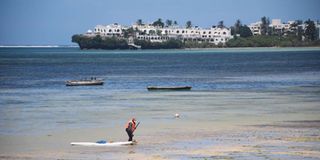Kenya to preserve discovered shipwrecks as underwater museums

A lone fisherman walks along the shores of the Indian Ocean at Jomo Kenyatta Public Beach in Mombasa County. Kenya has discovered more than 30 shipwrecks in the Indian Ocean.
What you need to know:
- Some of the newly-discovered shipwrecks are more than 500 years old.
- The National Museums of Kenya says the underwater museums are not yet open to the public.
The National Museums of Kenya has located more than 30 shipwrecks in the Indian Ocean with some dating back to 500 years ago.
The shipwrecks have now been protected as underwater museums.
Mr Ceaser Bita, the NMK chief underwater archaeologist, said the shipwrecks are a cultural heritage protected by law and are located in Lamu, Malindi, Kilifi and Mombasa.
“The East African coast has been vibrant for the last 2,000 years; there has been shipping and trade with the outside world such as India, Arabia, America and as far as Japan and China," he said.
The evidence of the East African coast trading with the outside world can be traced in ruins such as Gedi in Kilifi County, which was one of the largest and most prosperous towns in the 13th Century — until it was abandoned at the beginning of the 17th century.
Others are Mambrui, Mnarani Ruin, Takaungu Slave Market, Lamu and Malindi towns which date back to the 13th Century.
In an interview with the Nation at Mida Creek, one of the NMK marine heritage sites, Mr Bita said the government has done a lot of research on underwater archaeology that has made the country to be recognised among the world countries with vibrant underwater museums.
“We know where these sites are located, the type of ships, the material used to make them, and how we can access them, although research is still going on and we are still looking for more sites," he said.
The NMK underwater archaeologist said they believe there are still many shipwrecks lying at the seabed of the Indian Ocean which are yet to be discovered.
"All the shipwrecks found under water are properties of the Kenyan government and they need to be preserved for future generations," he said.
“Cultural heritage in Kenya is protected by law and to access these heritage sites, you have to go through the NMK."
Underwater museums
One of the perfect examples which Mr Bita gave to illustrate how the NMK is promoting underwater archaeology is the discovery of a shipwreck at Ras Ngomeni in Kilifi County which dates back to 500 years ago, displayed at Malindi Museum for public viewing.
"Though it sank earlier than Santa Antonio shipwreck in Mombasa, the Ngomeni ship, made from timber, has most of its major components such as frames, ribs and the base still intact. These remains make the site ideal for an underwater museum," he said.
Mr Bita said the shipwreck has been identified as a Portuguese vessel which sank in the 15th or 16 centuries, at a time when the Portuguese controlled the Western Indian Ocean trade.
"Materials and artifacts found on the site such as stone cannon balls, parts of stone anchors, lead plates and straps, copper ingots, Islamic green and black glazed pottery, wooden buckets, animal horns and ivory, iron nails have been displayed at the NMK in Malindi," he said.
However, he said the underwater museums are not open to the public but they are working on mechanisms that will enable the public to access the sites in future.
"We are not at that stage where we can say such sites can be accessed to the public bearing in mind the delicate nature of the shipwrecks which date back to 500 years ago," he said, adding "unless those seeking to access are researchers working on underwater archaeology''.
Mr Bita said underwater archaeology is an expensive venture and there was a need to train staff and equip them with underwater gear such as oxygen tanks, goggles and lights among others equipment before making the sites public.
"The underwater archaeological sites shall also need people to guard them to avoid looting, treasure hunting and damaging the delicate shipwrecks which have stayed in the salty seabed for centuries," he said.





